SQL Maestro for MySQL and MariaDB 25.3 released
Mar 21, 2025
| Prev | Next |
|
SQL Maestro Group is happy to announce the release of
SQL Maestro for MySQL and MariaDB 25.3,
Please consider the list of new features implemented in this version since the last official release: |
New feature highlights:
- This version has been successfully tested with all MySQL versions up to the latest version 8.4 and the innovation release 9.2 as well as with all 10.x and 11.x versions of MariaDB.
-
Support for a number of new features has been implemented as follows:
-
Invisible columns (MySQL 8.0.23+ |
MariaDB 10.3.3+).
Invisible columns are hidden to queries, but can be accessed if explicitly referenced.
To make a column invisible, just turn ON the appropriate checkbox in the Field Editor.
For clarity, invisible columns have a special icon in GUI. Picture 1. Field Editor: Invisible property
Picture 1. Field Editor: Invisible property
 Picture 2. Invisible column icon
Picture 2. Invisible column icon
-
Invisible (MySQL 8.0+) |
Ignored (MariaDB 10.6+) indexes.
Such indexes are not used by the optimizer.
Invisible (ignored) indexes make it possible to test the effect of removing an index on query performance,
without making a destructive change that must be undone should the index turn out to be required.
To mark an index as invisible (ignored) or as visible (not ignored), use the appropriate checkbox in the Index Editor.
Invisible (ignored) indexes have grayscale icon in GUI.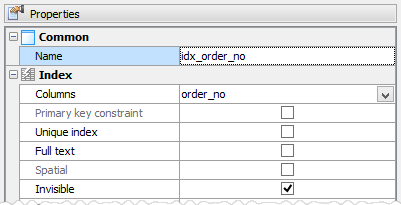 Picture 3. Index editor: Invisible index
Picture 3. Index editor: Invisible index
 Picture 4. Invisible index icon
Picture 4. Invisible index icon
-
Sequences (MariaDB 10.3+).
A sequence is an object that generates a sequence of numeric values.
It's an alternative to AUTO INCREMENT when one wants to have more control of how the numbers are generated.
Sequences can be used in DEFAULT to automatically generate values for a field.
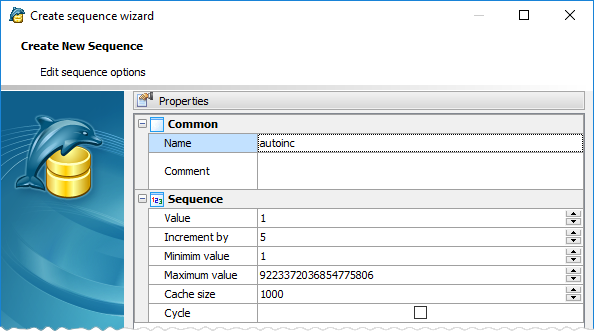 Picture 5. Create new sequence wizard
Picture 5. Create new sequence wizard
 Picture 6. Using sequences in default
Picture 6. Using sequences in default
-
Check Constraints (MySQL 8.0.16).
From now on you can add, edit, and drop named check constraints at the Checks tab of the Table Editor.
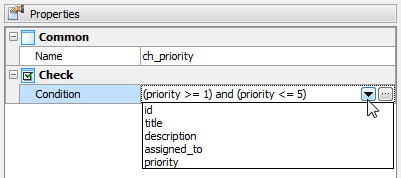 Picture 7. Check Editor
Picture 7. Check Editor
Note: Support for Check Constraints in MariaDB was added in the previous version of the software.
-
Added support for a number of password-management capabilities:
-
Password Reuse Policy (MySQL 8.0.3+).
This policy imposes restrictions on reuse of previous passwords. Reuse restrictions can be established based on number of password changes, time elapsed, or both.
If an account is restricted on the basis of number of password changes, a new password cannot be chosen from a specified number of the most recent passwords.
If an account is restricted based on time elapsed, a new password cannot be chosen from passwords in the history that are newer than a specified number of days.
 Picture 8. User editor: Password Reuse Policy
Picture 8. User editor: Password Reuse Policy
-
Password Verification-Required Policy (MySQL 8.0.13+).
This policy allows to require that attempts to change an account password be verified by specifying the current password to be replaced.
 Picture 9. User editor: Password Verification-Required Policy
Picture 9. User editor: Password Verification-Required Policy
-
Failed-Login Tracking and Temporary Account Locking (MySQL 8.0.19+).
It is possible now to track failed login attempts and lock the user account after a certain number of consecutive login failures.
 Picture 10. User editor: Failed-Login Tracking and Temporary Account Locking
Picture 10. User editor: Failed-Login Tracking and Temporary Account Locking
-
Password Reuse Policy (MySQL 8.0.3+).
This policy imposes restrictions on reuse of previous passwords. Reuse restrictions can be established based on number of password changes, time elapsed, or both.
If an account is restricted on the basis of number of password changes, a new password cannot be chosen from a specified number of the most recent passwords.
If an account is restricted based on time elapsed, a new password cannot be chosen from passwords in the history that are newer than a specified number of days.
-
Database Read Only option (MySQL 8.0.22+).
This option controls whether to permit modification of the database and objects within it.
Just turn ON the appropriate checkbox in the Database Editor to protect the database from changes.
 Picture 11. Database editor: Read only option
Picture 11. Database editor: Read only option
-
Database comments (MariaDB 10.5+).
It is possible now to add comments for databases.
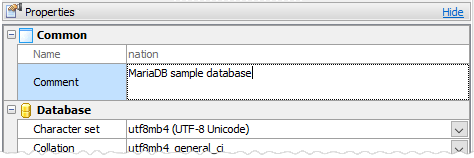 Picture 12. Database editor: Comment
Picture 12. Database editor: Comment
-
User comments (MySQL 8.0.21+).
Starting from this version it is possible to add comments for users.
 Picture 13. User editor: Comment
Picture 13. User editor: Comment
-
RENAME COLUMN syntax
(MySQL 8.0+ |
MariaDB 10.5+).
For changing a column name but not its definition, RENAME COLUMN is more convenient and safe than CHANGE, which requires respecifying the current column definition.
 Picture 14. Renaming column
Picture 14. Renaming column
-
Invisible columns (MySQL 8.0.23+ |
MariaDB 10.3.3+).
Invisible columns are hidden to queries, but can be accessed if explicitly referenced.
-
Starting from this version it is possible to select a client library for working with the database.
MySQL and MariaDB libraries are available.
 Picture 15. Client library
Picture 15. Client library
-
SSH client has been upgraded.
Now it supports more secure key exchange algorithms.
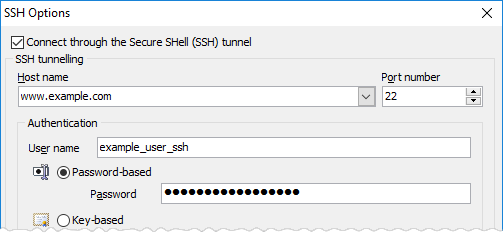 Picture 16. SSH Client has been upgraded
Picture 16. SSH Client has been upgraded
In addition to this, several bugs have been fixed and some other minor improvements and corrections have been made.
Related links:
| Prev | Next |








